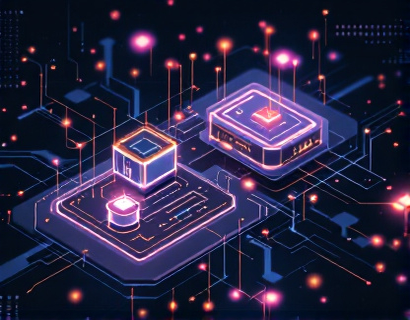Empowering Blockchain Creators: Streamlined Solutions for Custom Token and Currency Development
The landscape of blockchain technology has evolved significantly over the past decade, offering unprecedented opportunities for innovation and transformation. Among the most exciting developments is the ability for creators to design and launch their own custom tokens and currencies. However, the journey from concept to reality can be daunting, involving complex technical challenges, security concerns, and scalability issues. This article aims to shed light on the streamlined solutions available for blockchain creators, focusing on customization, security, and scalability, to make the process of developing digital currencies more accessible and manageable.
Understanding the Basics of Custom Token and Currency Development
Before diving into the solutions, it's essential to understand the fundamental aspects of creating custom tokens and currencies on the blockchain. A token is a digital asset that represents a specific value or utility within a blockchain ecosystem. Tokens can be used for various purposes, such as access to a service, representation of ownership, or as a medium of exchange. Currencies, on the other hand, are more akin to traditional digital money, designed to function as a store of value and a medium of exchange within a blockchain network.
The development of custom tokens and currencies involves several key steps: defining the token's purpose and utility, choosing the appropriate blockchain platform, designing the token's smart contracts, and ensuring compliance with regulatory requirements. Each step presents its own set of challenges, from technical complexity to ensuring the token's security and scalability.
Customization: Tailoring Tokens to Specific Needs
One of the primary advantages of creating custom tokens is the ability to tailor them to specific use cases. Standard tokens like ERC-20 on Ethereum offer a baseline functionality, but they may not fully meet the unique requirements of every project. Customization allows creators to design tokens with specific features, such as different token economies, unique governance models, or specialized functionalities.
Modern blockchain development platforms provide robust tools for customization. These tools enable creators to define custom token standards, modify existing standards, and integrate additional features. For instance, a creator might want to implement a token that rewards users for contributing to a decentralized application (dApp) or one that facilitates voting mechanisms within a community. Customization ensures that the token aligns perfectly with the project's goals and user needs.
Token Standards and Customization
Token standards are protocols that define the behavior and characteristics of tokens on a blockchain. The most well-known standard is ERC-20, which specifies the requirements for tokens to be compatible with the Ethereum ecosystem. However, ERC-20 has its limitations, particularly in terms of functionality and flexibility. To overcome these limitations, various custom token standards have been developed, such as ERC-721 for unique digital assets (NFTs) and ERC-1155 for multi-type tokens.
Creators can leverage these standards or create their own by modifying existing ones or developing entirely new ones. For example, a project aiming to create a utility token for a specific platform might extend the ERC-20 standard to include additional functionalities like token burning, staking, or dynamic pricing. This level of customization ensures that the token serves its intended purpose effectively and efficiently.
Security: Protecting Tokens and Users
Security is a paramount concern in blockchain token development. Ensuring the integrity and safety of tokens is crucial to maintaining user trust and preventing fraudulent activities. Security vulnerabilities in smart contracts can lead to significant financial losses and damage to a project's reputation. Therefore, implementing robust security measures is essential.
One of the primary ways to enhance security is through thorough smart contract audits. These audits involve a detailed examination of the code by security experts to identify and rectify potential vulnerabilities. Many blockchain development platforms offer integrated audit tools and services, making it easier for creators to ensure their smart contracts are secure.
Another critical aspect of security is the use of best practices in coding and deployment. This includes following established coding standards, avoiding common pitfalls, and using trusted libraries and frameworks. Additionally, implementing proper access controls and ensuring that sensitive operations require multi-signature approvals can significantly reduce the risk of unauthorized access.
Security Best Practices
To further bolster security, creators should adopt a multi-layered approach. This includes using secure deployment methods, such as signing contracts with hardware security modules (HSMs), and implementing robust testing protocols. Automated testing tools can help identify issues early in the development process, reducing the risk of bugs and vulnerabilities.
Moreover, educating team members about security best practices is essential. Regular training sessions and staying updated on the latest security trends and threats can help create a security-conscious development environment. Collaborating with security experts and leveraging community resources can also provide valuable insights and support.
Scalability: Ensuring Growth and Adoption
Scalability is another critical factor in the success of custom tokens and currencies. As a project grows, the token network must be able to handle increased transaction volumes without compromising performance. Scalability ensures that the token remains usable and attractive to a broader audience, fostering adoption and long-term sustainability.
Blockchain platforms offer various solutions to enhance scalability. Layer 2 solutions, such as state channels and sidechains, allow for off-chain transactions, reducing the load on the main blockchain and improving transaction speeds. Additionally, sharding, which involves dividing the blockchain into smaller, more manageable parts, can significantly increase throughput.
For custom tokens, creators can choose blockchain platforms that natively support scalability features. For example, platforms like Polkadot and Solana offer advanced scalability solutions that can be integrated into custom token projects. These platforms provide the necessary tools and infrastructure to ensure that tokens can scale seamlessly as the user base grows.
Scalability Strategies
To implement scalability effectively, creators should consider a combination of strategies. One approach is to use a combination of on-chain and off-chain solutions. On-chain transactions handle critical operations, while off-chain solutions manage less critical but high-volume transactions. This hybrid approach balances security and performance.
Another strategy is to leverage blockchain interoperability. By enabling seamless interactions between different blockchain networks, creators can tap into a larger ecosystem, enhancing the utility and reach of their tokens. Interoperability protocols like Polkadot's XCM and Cosmos's IBC facilitate this integration, allowing tokens to function across multiple chains.
Streamlined Development Process
To make the development of custom tokens and currencies more accessible, streamlined solutions are essential. These solutions should simplify the process from design to management, reducing the technical barriers and allowing creators to focus on their unique value propositions.
A comprehensive blockchain development platform can serve as a one-stop-shop for creators. Such a platform should offer a user-friendly interface, detailed documentation, and community support to guide users through each step of the process. Here are some key features that such a platform should include:
User-Friendly Interface
A intuitive and user-friendly interface is crucial for making blockchain development accessible to both newcomers and experts. The platform should provide clear guidance and step-by-step instructions, reducing the learning curve and making it easier for creators to navigate the development process.
Template and Starter Kits
Offering pre-built templates and starter kits can significantly speed up the development process. These templates can be customized to fit specific project requirements, providing a solid foundation for creators to build upon. For example, a template for a utility token with basic governance features can save time and effort compared to starting from scratch.
Integrated Development Environment (IDE)
An integrated development environment (IDE) within the platform can streamline coding and testing. The IDE should include features like code completion, error checking, and real-time debugging tools. This integrated approach ensures that developers can write, test, and deploy smart contracts efficiently.
Automated Testing and Deployment
Automated testing and deployment tools are vital for ensuring the reliability and security of smart contracts. The platform should offer built-in testing frameworks and deployment pipelines that automate these processes. This not only saves time but also reduces the risk of human error.
Community and Support
Building a strong community around the development platform is essential for fostering innovation and providing support. A vibrant community can offer valuable insights, share best practices, and collaborate on projects. Additionally, robust support resources, such as forums, documentation, and expert consultations, can help creators overcome challenges and optimize their projects.
Regular webinars, workshops, and tutorials can also play a significant role in educating creators about the latest trends and best practices in blockchain token development. By staying connected with the community and leveraging these resources, creators can enhance their skills and stay ahead in the rapidly evolving blockchain landscape.
Case Studies and Success Stories
Highlighting successful projects that have used the platform can serve as inspiration and provide practical examples for other creators. Case studies detailing the challenges faced, solutions implemented, and outcomes achieved can offer valuable lessons and insights. These stories not only demonstrate the platform's effectiveness but also build trust and credibility among potential users.
Conclusion
Empowering blockchain creators with streamlined solutions for custom token and currency development is crucial for unlocking the full potential of blockchain technology. By focusing on customization, security, and scalability, and providing a user-friendly development platform, creators can overcome the technical hurdles and bring their innovative ideas to life. As the blockchain ecosystem continues to grow, these streamlined solutions will play a pivotal role in fostering creativity, security, and adoption, paving the way for a more decentralized and inclusive future.










































